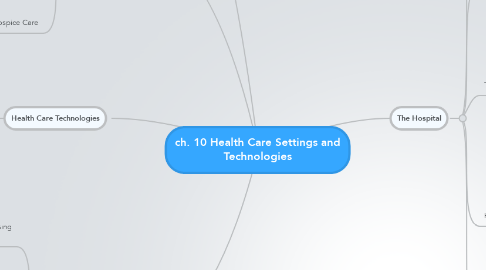
1. Nursing Homes
1.1. Gender, Age, Ethnicity, Class, and Nursing Home usage
1.1.1. Women are far more likely than men to be nursing home patients.
1.1.2. Residents are overwhelmingly over the age of 75
1.1.3. Overwhelmingly white (historcally)
1.1.4. Considerably sicker than nursing home residents 20 years ago.
1.2. Financing Nursing Home Care
1.2.1. About $200 per day per room
1.2.2. Most rely on medicare (at least initially)
1.2.3. Long term nursing home residents usually end up impoverished.
1.3. Working in Nursing Homes
1.3.1. Extremely labor intensive
1.3.2. rely on nursing assistants and licensed practical nurses
1.4. Life in Nursing Homes
1.4.1. Commodification - turning people into commoditites (to keep down prices)
1.4.2. Nursing assitants become budgeted expenses
1.4.3. Quality is worse in for profit homes than non profit homes
2. Hospices
2.1. Origins of Hospice
2.1.1. emerged out of growing public recognition that neither of these options (long term care and nursing homes) were appropriote for the dying
2.1.2. Lack of appropriate care for the dying led to the development of the hospice movement
2.2. Modern Hospices
2.2.1. primarly funded by insurers
2.2.2. Over half are for-profit
2.3. Use of Hospice
2.3.1. 40% of people who die use hospice
2.3.2. Medicare only pays 6 months
2.4. Outcomes of Hospice Care
2.4.1. Hospice clients survive an average of one month longer than those who receive ordinary medical care.
3. Home Care
3.1. The Nature of Family Caregiving
3.1.1. Typically out of love or psychological reward
3.1.2. Financial cost is substantial
3.1.3. Physical cost can be high - strenuous tasks
3.1.4. Often leave loved ones tired and low energy
3.1.5. Numerous psychological costs
3.2. Easing the Burdens of Caregiving
3.2.1. Respite Care and Family Leave programs were developed to ease the burden
3.2.2. Can turn to paid caregivers - nurses
4. Health Care Technologies
4.1. The Nature of Technology
4.1.1. Blank Slate
4.1.2. Nature and culture are important
4.2. The Social Construction of Technology
4.2.1. The process through which groups decide which potential technologies should be pursued and which should be adopted.
4.2.2. Political process
4.3. The Technological Imperitive
4.3.1. Refers to the belief held by both doctors and consumers that technology is almost always good, so it is almost alwasy appropriate to use all existing technological interventions, regardless of their cost.
4.4. Technology and the Changing Nature of Health Care
4.4.1. Doctors give far less attention to patients' reports of their health and far more attention to results from medical tests
5. The Hospital
5.1. The Premodern Hospital
5.1.1. Original hosptials were devoted to inpatient care of the "deserving" sick
5.1.2. Functioned as nonprofits and became known as voluntary hospitals because they relied heavily on unpaid charity work.
5.1.3. Chaotic and dirty places - mortality rates were high
5.1.4. Functioned as total institutions
5.2. Beginnings of the Modern Hospital
5.2.1. post civil war hospitals (modern)
5.2.2. Hospitals became more pleasant due to new knowledge regarding germs/illness
5.2.3. For profit, private hospitals began appearing - voluntary hospitals began to lose their ethos of service and became similar to for profit competitors.
5.3. The Rise of the Modern Hospital
5.3.1. The hospital building boom reinforced the class division within voluntary hospitals.
5.3.2. public hospitals - established to provide services to people with mental illness, chronic illness and the undeserving poor.
5.3.3. Surgical admissions surpassed medical admissions
5.4. Hospitals Today
5.4.1. Federal subsidies for hospitals expanded after the implementation of medicaid and medicare.
5.4.2. Diagnosis-related groups (DRGs) - have pressured voluntary hospitals to focus more on the bottom line and thus act more like for-profit hospitals.
5.4.3. Rather than fighting managed care over which treatments and services the insurers will cover, hospitals now increasingly offer extra services that patients are willing to pay for out of pocket.
5.5. The Hospital-Patient Experience
5.5.1. Patients enter hospitals needing emergency care
5.5.2. The highly technical nature of hospital care encourages staff to focus on the machiens and the data rather than on the patient as a whole person.
5.5.3. Medical training encourages doctors to focus on biological issues much more tahn on patient's psychological or social needs.
5.5.4. Large institutions necessarily concern themselves with cost and profits
